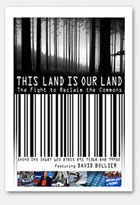
This Land is Our Land: The Fight to Reclaim the Commons 2010
Distributed by Media Education Foundation, 60 Masonic St., Northampton, MA 01060; 800-897-0089
Produced by Jeremy Earp and Andrew Killoy
Directed by Jeremy Earp and Sut Jhally
DVD , color, 47 min.
College - Adult
Business, Economics, Environmental Studies, Philosophy, Political Science
Date Entered: 04/14/2011
Reviewed by Michael J. Coffta, Business Librarian, Bloomsburg University of PennsylvaniaWhile some works simply bemoan the corporatization of America and its accompanying materialism, This Land is Our Land goes well beyond this on both fronts: it speaks to the whole world (not just the U.S.) and the human condition, and examines how the concept of ownership has permeated virtually all things. The film begins by proffering copious examples of relentless advertisements and free market capitalism scarring our culture and psyche. The filmmakers point to the concept of the “commons,” or things that are considered to be without ownership to be nurtured and proliferated for the common good. Examples of such commons include public land, water, and Jonas Salk’s polio vaccine. Salk did not patent the vaccine, but offered it for the common good. It is this mindset of offering commodities or inventions for consumption without ownership that the film holds in esteem. The documentary returns to disparaging the free market, giving examples of stadiums, schools, and even a town selling the rights to its name to corporate entities. In a very pointed example, the audience sees how drug companies successfully fought South Africa’s unapproved manufacture of generic AIDS drugs. This film continues with more instances of commons, such as the New Deal, Social Security, and the historical examples of Benjamin Franklin’s inventions. The audience also receives a heavy dose of environmental consequences of the free market’s activities, including the impact on the world’s fresh water supply.
The conclusion gives a good summary of the film, theorizing that the free market affects our identity, and our ability to “understand what is possible.” The film ends with a stream of examples of transnational, commons-conscious organizations and endeavors.
This is an exceptionally interesting and mind-bending film that accomplishes just what it sets out to do: stir the audience’s outrage toward corporate heavy-handedness, and challenge the audience to rethink the very bases for existence of certain commodities and phenomena. It offers a diverse mixture of business discussion, environmentalism, philosophy, and a good measure of discussion on government deregulation.